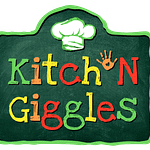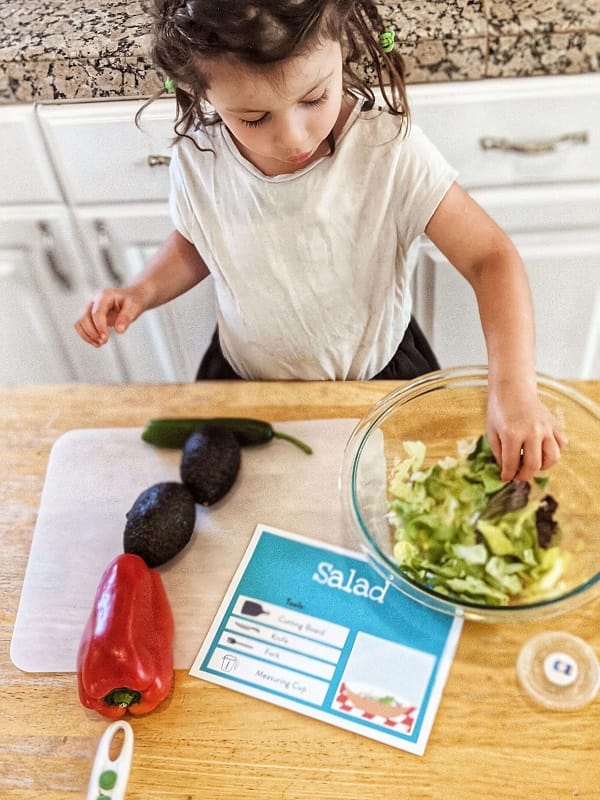Want to start cooking with your kids but unsure of how to actually do it? Then you’re in the right place.
I started trying to cook with my kids AFTER years of working as a professional chef, and it was hard. It took a lot more time and patience than I had!
I’m going to show you exactly what you need to get started. From tools to tips and tricks, I’m going to cover it all.
In order to win at cooking, or really anything in life, you’re going to need a plan. The surest way to fail at this is by saying “Kids, let’s all go cook!” Your plan will cover ingredients, tools and time, so that you can be best prepared to have the kids in the kitchen.
Let’s get started!
3 Pitfalls to Avoid
Ok, so before we actually start getting the kids in the kitchen, let’s examine the 3 reasons that so many parents are reluctant to cook.

It's Overwhelming
If you aren’t ahead of the game, then having the kids in the kitchen can easily spiral out of control. You’re hunting through the cabinets for some oregano, and they’re busy showering each other with shredded cheese. The key is to anticipate what the kids will need. Then gather all of your tools, supplies and ingredients before you gather the kids.
Having everything ready will make cooking smoother. And when you’re not distracted by measuring or preheating the oven, you’ll be better able to focus on the kids. So start simple. Get everything ready before hand, and things should be smooth sailing.

Cooking with Kids Take Too Long
The truth is that getting your kids to do anything takes a lot longer than just doing it yourself. If you barely have 15 minutes to throw dinner together, then how would you find 45 to do it with your kids? It’s true that there isn’t a lot we can do to add more time into our days, (if only…) So instead of committing to cooking dinner with your kids, you can limit yourself to a dish that can be done in 15 minutes or less. That could be a salad, or maybe even just a salad dressing.
The more comfortable your kids get in the kitchen, the faster they get too. So even if the first few times you only manage to mix up a dressing, or crack a few eggs, that’s a win! In a few more weeks, you’ll be cooking a 3 course meal.

Kids Aren't Interested
Yes, it is impossible to get your kids involved in cooking if they’re not interested. I would also rather play outside than make dinner,so I get it. The idea is to lower your expectations. Kids in the kitchen don’t necessarily have to cook. They could be rinsing vegetables, setting the table, or even sweeping the floor.
The more time the kids are in the kitchen, the more exposure they’re getting to important skills and techniques. And the more chance of them sneaking some sliced vegetables off the cutting board.
There’s a lot of work that goes in to cooking, and cleaning is an important part. So if your little chef isn’t in the mood for mixing or slicing, maybe you could entice them with some sweeping.
The best way to get your kids in the kitchen is to be prepared and consistent. Even small jobs, like rinsing produce, are effective ways to get the kids in the kitchen. So go ahead and test out getting your kids in the kitchen. It might be easier than you think.

The Pre-plan
Before you even think about getting your kids cooking, here are the questions you’ll need to answer in order to achieve success.
First, how much time do you have? Cooking with kids takes a lot more time than cooking alone. They’re still mastering these skills, so having time is a key component to cooking. If you’re short on time, check out some quick ways to get the kids involved.
Next, what recipe are you going to use? No, now is not the time to come into the kitchen and “wing it.” Make sure you have a recipe in mind. Be specific. So “a pasta dish” is not as good as “spaghetti and meatballs.” Even better, “Grandma’s Sweet and Sour Meatballs with Spaghetti.”
Then, gather up everything you need to execute your recipe. That means ALL of the ingredients. Don’t wait for the last minute to check if that garlic you bought last week is still good. You also need to get all of your tools together. Plus some extra spoons for taste-testing.
Now that you have a plan, you’re ready!

Prep for Cooking with your Kids
Once your kids enter the kitchen, you need to pay close attention to them. Turn your back for a second and all of that tomato sauce will end up all over the floor and at least 1 person will be in tears. When you have kids in the kitchen, you want to focus everything on them, which means you’ll need to do some extra prepping beforehand.
First, make sure your oven is on and at the right temperature. This is a good idea anytime you’re cooking, but especially when you’re cooking with people who have short attention spans. If you have your cookies all ready to pop in the over, the last thing you want to do is wait 10 minutes for the over to heat up. So cut down on your wait time but preheating your oven.
Next, measure everything out. I highly recommend this step if you’re cooking with kids under the age of 7. Measuring with preschool aged kids is hit or miss, and I mean mostly a miss. So save yourself that headache and do the measuring yourself.
Once kids have better fine-motor skills, measuring is a fun way to build up on some of those math skills. Again, help make it easy on them and you by having all of your ingredients and measuring tools ready to go.
Then, do the prep work that isn’t child-friendly. You definitely don’t want little fingers to end up on the cutting board while you’re chopping garlic. Any task that you don’t want your kids involved in needs to be completed before they come in to the kitchen. I usually do the fine dicing, peeling and veggie steaming. This depends on your child’s individual level of competence, so use your judgement.
Finally, read over the entire recipe. Which brings us to the next tip…

Organize Yourself for Cooking with Kids
This is the key to successfully cooking with your kids: organization. Let’s go over how to get yourself organized to make cooking with the kids a breeze.
So we start by reading over the entire recipe. This ensures that nothing falls through the cracks. You have all of your ingredients ready. The oven is warming up. Now you can sketch out a plan.
The first thing to keep in mind as you do this is timing. Timing is everything in cooking, especially in cooking with kids. So before you start executing your recipe, go over each step and estimate how much time you think it will take. Keep in mind that when the kids enter the picture, simple tasks take longer. Be realistic with your estimations.
Next, group your ingredients and tools by step. Start by placing all of the ingredients you need for the first step together. You can move everything else out of the way. The less stuff you have cluttering your cooking area, the easier it is to focus.
Don’t put things too far though, because you will need them soon. One trick I use is to place groups of ingredients on a baking sheet. Then you just grab the sheet you need. Bonus tip: Stack baking sheets on top of each other to save space.
Then, do the same with your tools. If there’s something you don’t need until the end, place it on the appropriate baking sheet. The less stuff you have laying around, the less trouble the kids can get into.
Finally, clean as you go. This is actually pretty easy if you’re already organized your tools and ingredients. Once you’re done with a step, gather up the dirty dishes and pop them straight in the sink or dishwasher. Even better, place all of the dirties on a baking sheet and have the kids help you clean up at the end.
Before moving on to the next step of the recipe, take a minute to wipe down any spills or messy hands. It saves time in the long run.
Set Realistic Expectations
Ok, so you have your recipe, your ingredients and your tools ready to go. So now what? What are some of the kitchen tasks that your little chef is ready for? Let’s go over what you can expect your child to accomplish in the kitchen.

Cooking Tasks for Kids
The good news is that kids are some of the most fearless chefs! They’re willing to try just about anything in the kitchen. The trick is setting them up with something that is age appropriate and safe. Here are a few ideas to help inspire you.
- Mixing. Lots of recipes require mixing in some form or another. From whisking eggs to tossing salad, most of cooking is combining ingredients. The best part is that mixing doesn’t require any special tools. A simple spoon and bowl work just fine. One word of advice: Make sure you always use a large bowl. It’s much harder to spill.
- Pouring. If you’re ready to have your child mix, then they can get involved in the pouring. Children are pretty good at pouring, although it does take practice. Try using a pitcher for liquids. The handle and spout help your child develop the control they need to pour without spilling.
- Scooping. Not all cooking involves scooping, but when it does, it’s the perfect task for a kid.
- Slicing. Can kids start using a knife? Absolutely! A child safe knife is a great way to safely teach your child how to cut. Soft fruits, like bananas, strawberries and cucumber are the ideal texture for beginner cutters. This is a skill that keeps building, so start them young.
- Peeling. If your child is ready to use a vegetable peeler, than this is another task for them. If they’re not, don’t worry. There are plenty of things they can peel using only their fingers. Tangerines, avocado and hard boiled eggs are all ingredients that will keep those little fingers busy for a while.

Kitchen Cleaning for Kids
Prepare yourself! Cooking with the kids gets messy. Even the best laid plans and most organized cooks will have extra mess to deal with. The best thing to do is be proactive. Have some extra towels on hand. But, this is also an opportunity to teach your kids about cleaning up.
There are a few simple cleaning tasks that your child can learn to accomplish. Pick one or two to start with, and build up from there.
- Putting dirty dishes in the sink. If your child can walk, then they can walk those dirty dishes to the sink. Have a dishwasher? Your child can even learn how to load the dishes into the dishwasher. Part of cleaning as you go means constantly gathering up the dirty dishes, which is a great cleaning task for kids.
- Wiping down the table. Good thing you have all those towels handy! Wiping up spills is another cleaning task for kids. They may need a little practice, but this is another good one to outsource.
- Sweeping the floor. A small dustpan and a hand-held brush are the only tools you need. Taller children might be able to handle a broom. This is the perfect cleaning activity for kids who love rolling around on the floor.
- Throwing out the trash/recycling. Not only is tossing the trash necessary, it’s a learning opportunity. Clean up time is great for teaching kids how to sort trash from recycling. You can even make it into a game, as long as everything ends up in the right bin.
- Washing dishes. This task is great for elementary aged kids, but even little ones can help with the washing. They need a sponge and some soapy water. Make sure they’re only washing dishes that are impossible to break. And of course, no sharp objects.

Take A Realistic First Step
Yes, it is impossible to get your kids involved in cooking if they’re not interested. I would also rather play outside than make dinner, so I get it. Keep your expectations realistic. The good news is that there are several ways to get your kids involved in the kitchen, even if they aren’t cooking.
- Let them pick the recipe. Meal planning is definitely a form of cooking. Some may argue it’s the most important step. So if you children aren’t ready to roll up their sleeves and jump right in, have them flip through a cookbook and pick out a recipe.
- Take them grocery shopping. This is easier said than done, but if you have the time and patience, bringing your child to the grocery store is a great way to expose them to healthy ingredients and to build up their interest in cooking. If you’d rather get a root canal than drag your kid to the store, then have them help unpack the groceries. Eventually they may just stumble across something they get excited about.
- Let them do some prep work. There’s no reason for you to manage all of the prep yourself! Have you child help you gather up ingredients or tools. Allow them to rinse produce, or peel garlic. The more opportunities we offer kids to be in the kitchen, the more likely they’ll want to stay.
- Have them set the table. Yes, this absolutely counts as being part of dinner prep. Plus, it’s one less thing for you do to. Same rules apply here, stay organized and have a plan. Your child may require a few demos before they’re ready to set the table on their own.
- Clean up. Cleaning is also part of cooking. If you child isn’t ready to cook, that doesn’t mean they can’t be part of the clean up.
TL;DR
There are so many benefits to cooking, but it’s also a little scary. By making sure to create a plan and set realistic expectations, you are on your way to success.
Have you tried it? Let me know how it went in the comments below.




